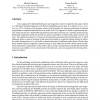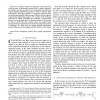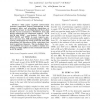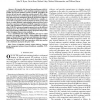ATMN
1996
14 years 2 months ago
1996
A new approach for bandwidth allocation and congestion control is reported in this paper, which is of the Rate Controlled admission with Priority Scheduling service type. It is ca...
MASCOTS
2001
14 years 2 months ago
2001
Abstract--Long-range dependence has been observed in many recent Internet traffic measurements. In addition, some recent studies have shown that under certain network conditions, T...
NETWORKING
2004
14 years 2 months ago
2004
A common feature of congestion control protocols is the presence of information packets used to signal congestion. We address here the question of how frequently such protocols nee...
ISCAPDCS
2001
14 years 2 months ago
2001
In this paper we investigate the network performance of TCP hosts and gateways employing New Reno TCP using a parallel simulator. The gateway adopts the random early detection (RE...
ICWN
2004
14 years 2 months ago
2004
This paper explores interactions between congestion control mechanisms at the transport layer and scheduling algorithms at the physical layer in the High-Speed Down-link Packet Acc...
SNPD
2008
14 years 2 months ago
2008
Peer-to-Peer file sharing applications, which enable peers to establish multiple TCP connections between other peers to transfer data, pose new challenge to congestion control. Si...
MASCOTS
2007
2007
A Novel Flow Control Scheme for Best Effort Traffic in NoC Based on Source Rate Utility Maximization
14 years 2 months ago
—Advances in semiconductor technology, has enabled designers to put complex, massively parallel multiprocessor systems on a single chip. Network on Chip (NoC) that supports high ...
CONEXT
2008
ACM
14 years 2 months ago
2008
ACM
In the context of mobile and pervasive networking, it is not uncommon to experience frequent loss of connectivity. Congestion control algorithms usually mistake resulting packets ...
CDC
2008
IEEE
14 years 2 months ago
2008
IEEE
The Internet is changing from being only an efficient platform for data delivery to become also a platform for audio/video applications. The stability of the traditional Internet i...
NGC
2000
Springer
14 years 4 months ago
2000
Springer
Abstract--We describe fair layered increase/decrease with dynamic layering (FLID-DL): a new multirate congestion control algorithm for layered multicast sessions. FLID-DL generaliz...




